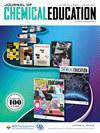为量子技术研究和教育开发晶体中原子样缺陷自旋存储器的 3D 模型
IF 2.9
3区 教育学
Q2 CHEMISTRY, MULTIDISCIPLINARY
引用次数: 0
摘要
量子技术(包括量子计算机和网络)的发展需要在可单独控制的量子比特之间分配纠缠。金刚石和硅的色彩中心正在引领固态量子比特,即所谓的 "人造原子"。人造原子已被证明可用于按需远程纠缠、对辅助量子比特进行相干控制(相干时间长达数分钟)以及增强记忆的量子通信。目前,研究和教育界都需要对人造原子进行清晰直观的可视化。在此,我们介绍一种基于 polyjet 3D 打印技术的新型可视化工具,用于创建原子缺陷的详细多材料多色 3D 模型,尤其侧重于金刚石和硅中的颜色中心。这些模型以手持形式(小于 2 英寸)精确地呈现了缺陷结构。我们利用打印机的功能,在同一生产流程中使用多种材料制作病人专用的逼真模型。这种方法通过提供互动工具和在 K-12 年级提前引入量子概念,加强了量子技术教育,培养了具有量子素养的未来一代。本文章由计算机程序翻译,如有差异,请以英文原文为准。

Developing 3D Models of Atom-Like Defect Spin Memories in Crystals for Quantum Technology Research and Education
The development of quantum technologies, including quantum computers and networks, requires entanglement distribution across individually controllable qubits. Color centers in diamond and silicon are leading solid-state qubits, so-called “artificial atoms”. Artificial atoms have been demonstrated for on-demand remote entanglement, coherent control of ancillary qubits with minute-long coherence times, and memory-enhanced quantum communication. There is an open need for clear and intuitive visualization of artificial atoms for research and education alike. Here we introduce a new visualization tool based on polyjet 3D printing technology to create detailed multimaterial multicolored 3D models of atomic defects, specifically focusing on color centers in diamond and silicon. These models accurately represent the defect structures in a hand-held form (less than 2 in.). We leverage the printer’s capability to deliver realistic patient-specific models with multiple materials on the same production run. This approach enhances quantum technology education by offering interactive tools and early introduction of quantum concepts in K-12, fostering a quantum-literate future generation.
求助全文
通过发布文献求助,成功后即可免费获取论文全文。
去求助
来源期刊

Journal of Chemical Education
化学-化学综合
CiteScore
5.60
自引率
50.00%
发文量
465
审稿时长
6.5 months
期刊介绍:
The Journal of Chemical Education is the official journal of the Division of Chemical Education of the American Chemical Society, co-published with the American Chemical Society Publications Division. Launched in 1924, the Journal of Chemical Education is the world’s premier chemical education journal. The Journal publishes peer-reviewed articles and related information as a resource to those in the field of chemical education and to those institutions that serve them. JCE typically addresses chemical content, activities, laboratory experiments, instructional methods, and pedagogies. The Journal serves as a means of communication among people across the world who are interested in the teaching and learning of chemistry. This includes instructors of chemistry from middle school through graduate school, professional staff who support these teaching activities, as well as some scientists in commerce, industry, and government.
 求助内容:
求助内容: 应助结果提醒方式:
应助结果提醒方式:


